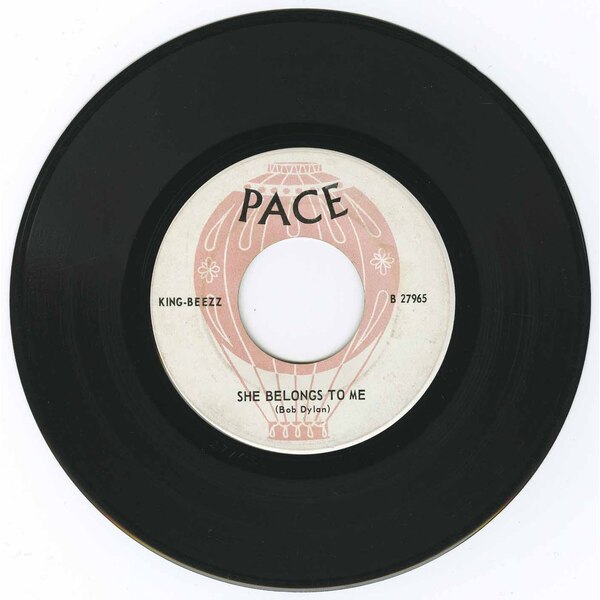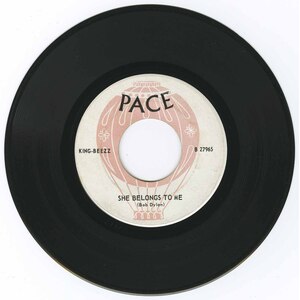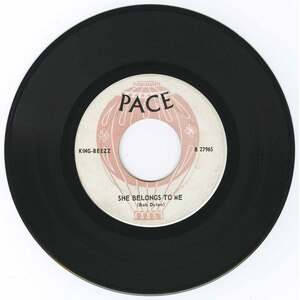Information/Write-up
Edmonton, Alberta is probably the last city you'd expect to be the birthplace of beat-punk ravings in Canada, but it is! Even before the larger metropolises of Montreal and Toronto experienced the might of bands like The Haunted and The Ugly Ducklings, The King-Beezz were tearing up Edmonton and swarming down on the region. Not only did the group usher in a new sound in the west, they revolutionized the entire scene, dragging it out of its fifties Rock'n'Roll mindset. As disciples of The Rolling Stones, The Who, The Kinks and The Pretty Things, they spread the gospel to a legion of unsuspecting teens, forever changing their meek existences! In a country notorious for its unforgiving cold climate, they blasted up some real scorchers like "Gloria," "Now," "I Gotta Move," "I Can't Explain" and "Found And Lost." All of these cuts have since been immortalized on compilations like Echoes In Time, Nightmares From The Underworld and volumes of Garage Punk Unknowns. Canada produced many superb acts during the sixties, but no other can match The King-Beezz, the quintessential garagebeat kings!
The province of Alberta sits high atop the US states of Washington, Idaho and Montana. Nestled somewhere in the middle of this land mass is Edmonton, a fast growing city with a population which was pushing the half-million mark by 1964. At a time when radio was king, CJCA owned the lion's share of the market. The station was notorious for being the (in)breeding grounds for many local combos (The Nomads, The Lords, and even Wes Oakus' Rebels held cozy jobs there). Although Hal Weaver wasn't a rock star, he shared the fantasy. Weaver hosted a popular new Saturday night show called "The Liverpool Hour," arguably the first show to bring the British Invasion phenomena out west. When a phone-in contestant rang CJCA one night, Weaver nearly fell off his seat -it was some guy named Ron McLachlan, with a REAL English accent! He later discovered that it was Scottish, but that made little difference 'cause back in the Beatle-mania days a genuine accent of any kind got you a lot of mileage. After a brief conversation with this outstanding young man, wheels set in motion deep inside Weaver's skull. He the invited his #1 listener out for lunch the next day.
Ron McLachlan and Carl Peterson both emigrated to Canada from their native Scotland. Back in Glasgow they'd studied dentistry and when jobs presented themselves in 1964, they split for Canada. In Edmonton they worked for practices in the Birks building (which incidently, also housed CJCA) and lived in a nearby basement flat. Days after his initial encounter, Weaver began hanging out with the fellas on a regular basis, and it wasn't long before he voiced his idea of starting a beat group. Carl mentioned that he was playing acoustic guitar with a local folk group, but that he would be interested in doing something more intense. Ron had previous experience on drums, having toyed around with a kit back in the UK. Selecting what he thought was the simplest instrument, Hal said he'd take up the bass. Adopting their name from the first Stones LP, they decided to add a few Z's to give it a wilder, maybe even a dangerous connotation. The King-Beezz were born. In a stroke of pure marketing genius, Weaver introduced the group on his radio show. As in-studio guests of "The Liverpool Hour," The King-Beezz got the phone ringing off the hook the very instant a word was uttered. Carl really hammed it up too, stowing away those rolling Scottish r's to capture that ever so popular banter! This went on for a few weeks, then all of a sudden a fan club erupted. Over the next month, they checked out a few pawn shops and scored the right gear. They also put the word out that they were looking for additional musicians. The first recruit to come forth was also a Scot- Alan Cramsie played guitar, but better than that he actually had really long hair (and bright red at that)! Next to join was a 16 year old local boy by the name Bob Richardson. Despite his years, he convinced the guys he was a seasoned player. At his audition, he impressed them so much with his renditions of "Memphis" and "Ric-A-Tic" that they snapped him right up on the spot as their lead guitarist. Much to their surprise they later discovered that those were the only two numbers he knew! Since it had become quite evident that Weaver was never gonna play bass, others were tried out. By the time 1965 had rolled in, Ray Carson had completed the line-up.
For reasons unknown, CJCA decided to give Hal Weaver the axe in May 1965. The group only discovered this the day before they were booked for another one of his shows, which up till now remained their sole outlet for exposure. Weaver's reluctant successor was Chuck Camroux, or Bob Stagg as he was known professionally. Chuck returned to Edmonton after several years working in the maritimes and in Ontario. Overwhelmed with work before he even settled in at CJCA, The King-Beezz - whoever they were - were the last thing on his mind - understandably, the group became concerned. Within only a few weeks, Camroux became the city's hottest deejay, and one night after signing off, Camroux invited the band to practice in the studio since the place was deserted. He still hadn't heard them, so this was a perfect opportunity. They tore through a few numbers, then asked what he thought. Camroux was blunt: The band were terrible. They simply could not hold a song together and forgeta bout any stage presence, there was none! He suggested some serious practice - lots and lots of it.
The summer of 1965 saw the king-Beezz breaking out on to the high school scene. Chuck started booking them around town, but still hadn't committed himself to managing them. Although stage fright and inexperience got the better of them, these early shows were memorable for the sheer amount of frenzy and and adoration the young audiences provided. One thing for sure, they were an oddity; the first long hair act in the region, plus they had members from the UK, which in the eyes of many was the same thing as being a UK act! Russ Campbell, a deejay at rival CHED commented that: 'The King-Beezz were so different, so alien to the landscape, that you couldn't hep take notice of them. Either you thought they were cool, or a bunch of freaks!"
Back at CJCA they started cutting demos. With the help of Mike Grant, the station's engineer, Chuck produced a handful of numbers. Although the conditions were totally primitive and the recordings were all done direct to a one-track Ampex A4-40, the session did produce a few gems. Among those eventually released were versions of Bob Dylan's "She Belongs To Me" and Them's "Gloria."
By September it was time for a single. A meeting with Ray Schwartz, owner of the newly opened Downtown Recording Studio, led to a custom pressing on his new Pace label. Essentially a vanity pressing, only 100 copies were ever churned out. The record tops a very primitive and snarling rendition of "Gloria" (which actually has Ron playing drums with maracas taped diagonally off his sticks!) with "She Belongs To Me," a version so eerie and treble-laden, one could easily mistake it for an early Velvet Underground demo. The single charted at CJCA and helped raise their booking price. In addition to the record, promotional packages were sent out to the country's top labels, but no deal resulted -in fact, they didn't even elicit one response! The few remaining singles were likely snapped up at The Groove Spot, a hip new record shop which was part owned by Camroux. The King-Beezz were hot property but, with no recording deal in sight, Camroux was forced to call in some old favors. He'd sent a package to the head of Quality Records, George Struth, and Struth owed him one. After numerous phone calls he finally agreed to press the single on the Quality label, but opted to place "She Belongs To Me" as the top side. Re-released in November, the 45 went nowhere. Then deejays began playing the other side and by Christmas things started happening. As "Gloria" took flight on the "national" chart published by RPM (Canada's version of Cashbox or Billboard), stations from coast to coast began taking notice. Over that winter 15,000 sold and for a Canadian act that was considered a true hit!
Although pleased with the record's success, the group was disappointed with Quality. In October, they redid "Gloria" and the improvement was really obvious. The new take featured some killer guitar fills, plus a proper ending. In a miserly effort to cut costs, however, Quality used the same stampers created for the Pace release. Judging from the success of the first "Gloria," one can only speculate how much farther they could have gone with the updated version.
A national hit made touring essential. They had already branched out of the local high school and community centre circuit and ventured to Calgary, Red Deer, Banff, Jasper and western British Columbia. After covering that ground a few times they set their sights east. Making a 5,000 mile trek, they leveled Saskatoon, Winnipeg and Thunder Bay before linking up with bookings in southern Ontario that were arranged by Ron Scribner of The Bigland Agency. The group took all these places by storm, including Toronto's hip clubs, the Gogue Inn and the Night Owl, where they stayed on for a week apiece. Somehow on their tight schedule they also found time to sweep through many small towns. In addition, they managed no fewer than 10 television appearances. If that wasn't enough, they also recorded a follow-up single at RCA Victor Studios. Striking when hot, Camroux flew to Toronto and went directly to Quality's Birchmount Road headquarters where a deal was signed for a full-Iength LP. Up until this point, The Guess Who were the only Canadian beat group to have an album on the Quality label, so this was definitely a BIG deal.
The King-Beezz gigged on a full-time basis and that's how they made their living. The bookings and flow of money was so constant that in 1966 they were all put on weekly salary. Camroux remembers getting a phone call in the middle of the night from the guys, who were just hitting the city limit. They wanted to swing by and drop off their take from a mini-tour. What they delivered was a big suitcase crammed with $1 and $2 bills!
On the road they lived many interesting experiences and, as one can imagine, had their fair share of runins with the law - in fact, they were rousted quite often. One vivid memory they share is a time they had to unload their gear-packed van alongside the highway while a redneck Lloydminster constable inspected everything for dope (which they never touched). Simple things, like hanging back after a gig at the "Peach Festival" in Penticton, BC, when they all wound up at the police station after Alan complained (plus told the guy to go fuck himself!) because the large soda he ordered was only half full. They were a long hair act, so that made them an easy mark. The prejudice the cops had against them never led to serious trouble or bodily harm, but did prove to be a nuisance. To relieve tension they often cracked jokes with the police - usually at their expense! Innocent or not, they acted cocky and naively believed that no harm would come to them. As we know, many musicians elsewhere weren't so lucky.
Their next single really captured them in full glory. Unlike their counterparts in Europe, The King-Beezz were not directly influenced by American blues legends. To them, The Rolling Stones were gods. Like their heroes, they began adding their own signature to the covers they played. First, it had to be forceful and then it had to he fast. Repeating the formula of two back to back non-hits, Quality paired a blistering version of The Who's "I Can't Explain" with an equally vibrant take on The Kinks' "I Gotta Move." Although they readily admit that they could have used Shel Talmy's assistance, had they, the primitive power exerted on these renditions would have surely been lost. Due to the surprising lack of promotion for this single, only 3,000 copies purportedly sold. Quality Records didn't really know what it was doing and consequently many incredible Canadian records were launched into total obscurity. Using the poor sales figures against them, the label threatened that unless another hit like "Gloria" was produced there would be no album.
Meanwhile, continuing their never ending tour, The King-Beezz worked their way back west. In Winnipeg they shared the bill with labelmates The Guess Who, shaking the walls of The Pink Panther Club (a large basement venue converted from a bowling alley) with a fuzzed-out version of "Come See Me." They also made it back home on time for the big Klondike Days bash at Exhibition Park. Earlier on in the year, Ray Carson had been sacked and replaced with Don McLean. Now the grueling pace claimed Bob Richardson, bringing Derry Stewart into the fold. Bob had been struck with polio at a young age and the disease left him weakened. Many thought it was some sort of a gimmick, but Bob sometimes played sitting. Next to go was drummer Ron McLachlan; his retirement led to Dan McCoy joining. Fortunately the line-up remained stable over the next six months, giving the group enough time to come up with a new battle plan.
Quality Records blindly launched a third 45 in October. "Found And Lost," a bluesy, percussion heavy number, was recorded earlier on in the year at Downtown Studios. By contrast the flipside, "Now," is a harp wailing, maracas shakin' raver which dates back to their CJCA demos of 1965. While both sides are great they'd hardly be considered Top 40 fare however. Evidently Quality wanted a real flop to kill the LP deal which they were no longer committed to. It was time to part ways with the company, and one phone call to Struth's office was all it took. Despite the falling out, the group continued touring across the country promoting the single during the months of November and December.
1967 brought on its share of change. First Terry Thomas took over on rhythm guitar for Alan Cramsie. The group held a meeting and carefully plotted a new strategy to help them land a new recording deal. The plan was that they would produce an entire album on their own, then shop it around. Although they originally planned on recording in Seattle, they wound up at Minneapolis' Soma Recording Studios. Everything went off without a hitch and following the session they resumed touring, this time making it as far east as Montreal. They were booked to play an entire month at the world's fair, Expo '67, and their success was nothing short of phenomenal. In a blink, one month became three! An average day consisted of two gigs at the Expo site, then maybe a high school or nightclub afterwards. One of the highpoints of the Montreal trip was appearing on CFCF's popular teen show "Like Young." They even got to meet Muddy Waters, who was also a guest!
While The Beezz were doing their thing, so was their manager. The details are still a little sketchy, but it would seem that Chuck landed a deal with the newly restructured London Records. The label proceeded to hand over a single to an independent label for release, possibly to test the waters. Jet Records was owned by Don Wayne Patterson. Patterson actually wanted the band to lay down two songs from their repertoire ("San Franciscan Nights" and "Brown Eyed Girl") in French for the lucrative Quebec market. Fortunately for us, they declined and two sides from the Soma session were used; "Sean's Song," a great folk-rock jangler that still manages to retain a British influence, plus a throwaway, a bluesy version of "Wine Is Fine."
Even though the group was making money hand over fist, this tour had done them in. By the time they returned to Edmonton in mid-November, they were completely burnt out. Jet released their final record in December and, predictably, it went nowhere. Apparently only 500 copies were pressed so the fact that London was the national distributor came as little consolation. They'd been sold out by a major and the contract they worked so hard to snare was, for all intents and purposes, worthless.
Morale was at an all-time low that Christmas. Suffice to say that they all saw the writing on the wall. They'd gone farther than most acts around them, but the sad reality was that they'd gone as far as they could in Canada. Short of landing a deal in the US, their fate was sealed. The break up occurred in early 1968 when Carl Peterson, the last original member, announced he was leaving.
-Alex Taylor
from Ugly Things, Issue 15, 1997



No Comments